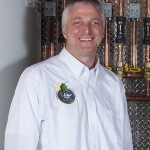June 10, 2013 VRF Technology – Contracting Business Magazine Article
VRF Technology
Variable Refrigerant Flow (VRF) is a technology introduced as a system to minimize efficiency losses found in conventional HVAC systems and provide sustainable energy benefits.
“Variable refrigerant flow comfort systems consist of multiple evaporators with variable capacity, connected to one central variable-capacity inverter-driven heat pump. These systems feature a heat-recovery mode that allows the transfer of energy from zone to zone with minimal compressor use. Each zone has its own indoor air unit that precisely controls the temperature while operating at peak efficiency levels, providing an unprecedented level of flexibility for those who work together in a building.”
LG VRF Techology
An air source LG VRF system is engineered to minimize or use no ductwork, save on the cost of large distribution fans, multiple water pumps operation and water piping. Energy efficient and easy to design, install, and maintain, a VRF system has the lowest life cycle cost of any system on the market today.
Exerpt from Contracting Business Magazine Article
VRF: Proven Technology Provides Specialized Solutions
Variable refrigerant flow comfort systems are gaining in popularity among enterprising HVAC contractors.
May 30, 2013
Terry McIver | Contracting Business
TJ’s Plumbing & Heating, Attleboro, MA has been in the HVAC business for 25-years, serving residential and commercial customers throughout the state of Massachusetts. The five-technician firm installs mini-split systems, traditional forced air heating and cooling, geothermal, and radiant systems.
Founder/owner Tim Cutler jumped into using VRF products about three years ago. For commercial applications, he’s certified in LG’s Multi V III, which he likes for its load diversification features. “You can heat one side of a building, cool the other, and use the waste energy from the cooling for the heating side,” he says.
In residential applications, Cutler likes the serviceability of VRF systems. “It’s very contractor friendly, from easy access to easy mounting. It’s virtually silent and very effective. We’ve installed them in bedrooms; that’s how quiet they are.”
Cutler’s strategy in designing VRF for a home application begins with explaining it as an option for areas without ductwork. Aesthetics are a key point.
“It’s mostly based on learning whether the client is fine with having a mini-split cassette on the wall. A lot of clients aren’t willing to do that, and for those customers we use LG’s 12,000 BTU high static, ducted air handler system.”
“VRF provides multi-zone capabilities, which allows the client much more flexibility, all from one compressor section. You might have four or five air handlers throughout a home, which allows for more zone control. It’s also a simplified set-up. You wire it up, everything communicates, and it’s easy for the end-user and easy for the contractor to install.”
Read the article in its completion…
Blog Archives
- February 2023
- January 2023
- October 2021
- September 2021
- February 2021
- August 2020
- July 2020
- April 2020
- March 2020
- February 2020
- October 2019
- March 2018
- February 2018
- November 2017
- August 2017
- April 2017
- March 2017
- February 2017
- January 2017
- September 2016
- January 2016
- June 2015
- April 2015
- March 2015
- February 2015
- January 2015
- August 2014
- May 2014
- April 2014
- March 2014
- February 2014
- November 2013
- August 2013
- July 2013
- June 2013
- May 2013
- April 2013
- March 2013
- February 2013
- January 2013
- December 2012
- October 2012
- August 2012
- June 2012
- May 2012
- April 2012
- March 2012
- February 2012
- January 2012
- December 2011
- November 2011
- October 2011
- September 2011
- August 2011
- July 2011
- June 2011
- April 2011
- February 2011
- January 2011

